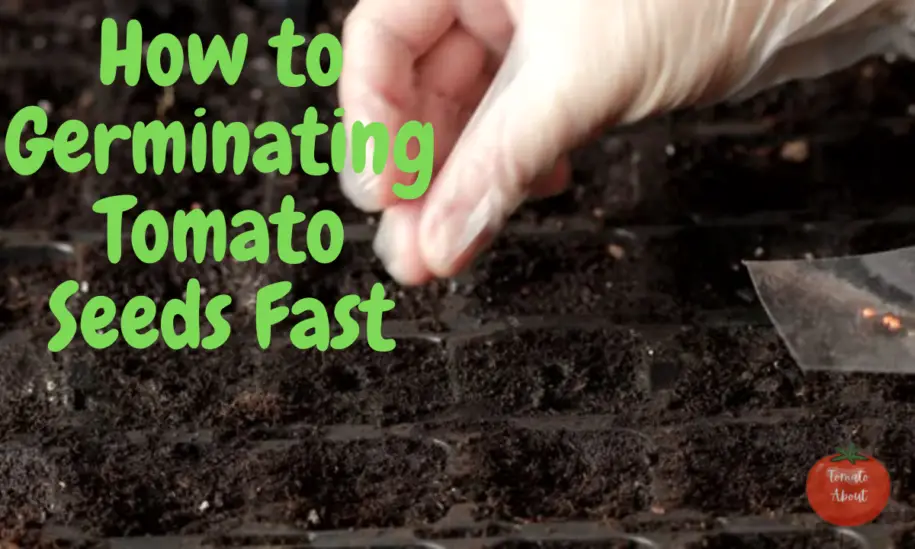Key Takeaways
- Provide warmth, moisture, and oxygen to trigger seed germination.
- Start seeds indoors 4-6 weeks before last frost based on your climate.
- Plant seeds 1/4 inch deep in sterile, well-drained starting mix.
- Keep soil moist and move to light after sprouting for healthy seedlings.
- Transplant tomato seedlings to the garden after 4-6 weeks when they reach 6-12 inches tall.
The arrival of spring brings the excitement of starting another tomato growing season. For me, nothing beats the thrill of planting tiny tomato seeds and watching them grow into robust, fruit-bearing plants. But before you plant those seeds, it’s important to understand the process of germinating tomato seeds properly.
In this comprehensive guide, I’ll walk you through everything you need to know to germinate your tomato seeds successfully. From optimal conditions and timing to step-by-step planting instructions, you’ll have all the information needed for the best possible start to your tomato crop.
What Triggers Germination?
For a tomato seed to transition out of dormancy and begin sprouting, it requires three key elements:
- Water – Absorbing water is vital for a seed to initiate metabolic processes and growth.
- Warmth – Tomato seeds germinate best at temperatures between 75-85°F. Warmth kickstarts enzymatic reactions.
- Oxygen – A seed needs air circulation to “breathe” as it germinates. Good drainage prevents suffocation.
Providing these three conditions will set the stage for successful tomato seed germination.
Why Start Tomato Seeds Yourself?
While it may be tempting to simply buy starter plants from your local nursery, there are some great benefits to starting your own tomato seeds:
- Wider variety: Nurseries have limited selections, but you can choose from hundreds of tomato seed varieties to find the perfect ones for your garden.
- Timing control: Starting seeds yourself allows you to time germination perfectly based on your climate and planting dates.
- Cost savings: Purchasing seeds is much cheaper than buying starter plants. Just a couple of dollars of seeds can supply an entire season’s worth of plants.
- Stronger transplants: Plants grown from seed are less likely to suffer transplant shock than purchased nursery plants.
As long as you understand the germination process, starting tomato seeds is easy and rewarding. Now let’s go over the optimal conditions for sprouting.
Supplies Needed for Germinating Tomato Seeds
While tomato seeds aren’t too demanding, having the right supplies makes the process easier and improves success rates.
Essential Supplies
These basic supplies are must-haves when starting tomato seeds:
- Containers – Shallow containers like seed trays allow you to germinate lots of seeds efficiently. Individual peat pots work too.
- Seed starting mix – Use a lightweight, soilless mix to avoid disease issues. These provide great drainage.
- Seeds – Stock up on your favorite heirloom or hybrid varieties. Tomatoes usually have a high germination rate.
- Spray bottle – Use clean water to keep seeds moist until they sprout. Misting prevents drying out.
Helpful (But Non-Essential) Supplies
These additional items can be helpful for starting seeds, but aren’t strictly necessary:
- Grow lights – While not essential at the germination stage, they will be needed after sprouting to keep seedlings strong.
- Heating mat – Maintains optimal soil warmth for quicker germination. Keep between 75-80°F.
- Dome lids – The high humidity created by domes help retain moisture in seed starting mixes.
- Labels – Identify varieties to avoid mix-ups. Use permanent marker on plastic or wooden picks.
Now that you know which supplies to gather, it’s time to actually plant those seeds!
What Tomato Seeds Need to Germinate
Tomato seeds require warmth, moisture, and oxygen to break dormancy and begin sprouting. Here are the ideal levels for each:
The ideal temperature range is 75-90°F (24-32°C). Cooler temperatures below 65°F (18°C) can inhibit or delay germination. Seeds and seed starter mix should be kept consistently moist but not soaked. Allow pots to partially dry out before watering again. Make sure seeds are planted at the proper depth to prevent a lack of oxygen. Gently fan seedlings daily after sprouting.
Maintaining these three conditions will enable the highest tomato seed germination rates and vigorous young plants. Now let’s look at when and how to plant indoors.
When to Start Tomato Seeds Indoors
The timing of planting tomato seeds indoors depends on two factors:
- the desired transplant size
- local last frost date.
Most tomato varieties perform best when transplanted at 4-6 weeks after germination. This allows enough time for seedlings to develop a strong root system but prevents excessive growth that could lead to leggy and weak plants.
To determine when to start seeds, count back 6 weeks from your average local last frost date. This gives you the ideal window for sowing seeds indoors. For example, if your last frost is May 15th, you would start seeds indoors around April 1st. Refer to frost date maps or your local extension office to find this date for your area if unsure.
Starting seeds too early can cause plants to outgrow containers and become root-bound. Too late may not allow enough growth before setting out transplants. Use the timeframe above for best results.
Step-by-Step Guide to Planting Tomato Seeds
Follow this simple method for excellent tomato seed germination:
Step 1 – Fill seedling containers with moistened seed starting mix
- Choose containers like plastic seedling flats, peat pots, or other small pots. Make sure there are drainage holes in the bottom.
- Prepare your seed starting mix by moistening it before filling the containers. You can do this by mixing water throughout the dry mix until it feels uniformly damp.
- Scoop the moistened mix into the seedling containers. Smooth the surface, then gently press down to lightly compact the soil.
- Fill each container to about 1⁄4 inch from the top rim. This leaves appropriate space for watering.
Step 2 – Plant seeds 1⁄4 inch deep
- Take your tomato seeds and carefully place 1 or 2 in each cell or pot, spacing them evenly.
- Gently press each seed about 1⁄4 inch down into the seed starting mix. The tip of your finger or a pencil eraser works well for this.
- Cover the seeds lightly with a bit more mix if needed so they are just buried. Don’t plant too deeply.
Step 3 – Mist soil surface
- Use a clean spray bottle filled with water to mist the soil surface after planting.
- Spray until the soil is noticeably darker and glistening, but not saturated or puddled.
- This ensures the seeds have the moisture they require to trigger germination.
Step 4 – Cover containers with plastic dome or wrap
- Place a plastic humidity dome designed for seed trays over the planted containers. Or improvise with plastic wrap or a cut-off plastic bottle secured with a rubber band.
- This creates a mini greenhouse environment to prevent the soil from drying out during germination.
- Remove any coverings as soon as the first seedlings poke through the soil.
Step 5 – Place in a warm location
- Tomato seeds germinate best at temperatures between 75-90°F. Make sure they will be in a suitably warm spot.
- Consider placing it on top of a fridge, near a heating vent, or use a heating mat or heat lamp to maintain optimal temperatures.
Step 6 – Keep seed starter mix moist
- Check the seed trays or pots daily to ensure the mix stays evenly moist. Gently poke your finger in to assess moisture.
- Use the spray bottle to mist soil as needed to replenish moisture. Don’t let it dry out or become waterlogged.
- Proper soil moisture is critical throughout the germination period.
How to Care for Newly Germinated Seedlings
Once those tiny tomato sprouts emerge, they need slightly different care to grow into strong transplants:
Move seedlings to bright, indirect light after germination. Turn containers regularly so seedlings don’t stretch toward light. Temperatures can now be kept cooler around 65-75°F (18-24°C) during the day. Allow starter mix to partially dry out between waterings. Misting leaves is beneficial. Gentle air movement strengthens stems, so rotate seedlings and use small fan to circulate air. Apply soluble tomato fertilizer at half-strength 1-2 weeks after emergence. Lastly, move seedlings to larger containers with potting mix once first true leaves appear.
Proper care during this critical stage ensures your tomato plants grow into sturdy transplants ready for the garden.
Common Problems When Germinating Tomato Seeds
If you notice issues with your seedlings, here are some potential causes and solutions:
If seeds are not sprouting, temperatures may be too low or soil too dry. Increase warmth and mist soil. Leggy or spindly seedlings indicate not enough light. Move to brighter location and rotate plants. Wilting plants could mean the soil is drying out. Water more frequently but avoid oversaturation. Damping off disease is caused by too wet conditions and poor air circulation. Allow soil to partially dry before watering and increase airflow. Curled, damaged leaves are a sign of cold temperatures. Raise temperatures and provide wind protection.
Pay close attention in those first few weeks after germination to keep your tomato plants healthy and strong. Now let’s look at precisely when and how to transplant your seedlings outdoors.
Transplanting Tomato Seedlings to the Garden
Your goal is to time transplant so that tomato seedlings are about 4-6 weeks old and around 6-12 inches (15-30cm) tall. This size prevents shock but avoids root-bound plants in small containers.
Tomato plants can be transplanted outdoors once all danger of frost has passed. Use row covers or cloches if needed for cold protection after transplanting.
Here are some tips for a successful transition to the garden:
- Harden off plants by slowly introducing them to outdoor conditions over 7-10 days.
- Water plants thoroughly a few hours before transplanting.
- Dig holes slightly larger than root ball or container.
- Set the transplant top at soil level and fill in around, gently firming down the soil.
- Water newly planted seedlings well to eliminate any air pockets.
With proper germination technique and this transplanting guidance, your homegrown tomato plants will be thriving in no time!
Tips for the Best Tomato Seed Germination
After going through the process many times, here are my top tips for getting the highest tomato seed germination rates:
Always use fresh seed each year – viability reduces over time. Plant 2 seeds per cell to ensure at least one sprouts if germination is spotty. Bottom-water seedlings to keep surface mix appropriately moist. Use sterile seed starting mix instead of garden soil to prevent disease. Gently brush sprouts with your hand to stimulate stem strength. Avoid letting plants get severely root bound before transplanting. Introduce gentle air flow with small fan to toughen seedlings.
Follow the steps outlined in this guide, and you’ll be rewarded with a bountiful tomato crop grown from seed. I wish you the best of luck this growing season! Let me know if you have any other tomato seed germination tips to share.
Germinating Tomato Seeds in Water
While most tomato seeds are started in a seed starting mix, some gardeners have success sprouting them in plain water. This method provides easy visibility to monitor the germination process.
However, there are some downsides to be aware of when germinating tomato seeds in water:
Pros
- Allows easy viewing of germination
- Minimal supplies needed
Cons
- Higher risk of mold or rot
- Weak seedlings prone to disease
- Requires earlier transplanting
If you wish to try water germination, here is a simple process:
- Place seeds between damp paper towels and leave for 2-3 days until sprouted.
- Transfer sprouted seeds to small container filled with room temperature water.
- Place in sunny window, changing water every 1-2 days.
- Transplant to soil after sprouts have 2-4 true leaves.
While an interesting experiment, germinating in soil is still the recommended method for best results. But water sprouting can work if seedlings are moved to soil quickly.
When to Give Up On Germinating Tomato Seeds
Patience is required when sprouting tomato seeds, but there comes a point when viability may be lost. Here are some guidelines on when to consider a seed batch unsuccessful:
- No sprouts after 2 weeks: With warm soil and proper moisture, tomato seeds generally sprout within 5-12 days. If none have emerged after 14 days, the seed batch may have low viability.
- Fungus visible: If fuzzy mold begins growing, the wet environment has led to fungus which can kill seedlings. Discard seeds and sterilize trays.
- Majority of seeds unsprouted: Expect 80-90% germination rates if seed batch is fresh and stored properly. If more than half fail to sprout, the seed is likely no longer viable.
- Sprouts weak/dying: Any sprouts that emerge but fall over and die indicate the seeds lacked enough vigor to fully germinate.
While not ideal, it’s sometimes part of gardening to lose a batch of seeds. When in doubt, it’s best to discard and start over rather than trying to salvage unhealthy plants. With fresh seed and optimal conditions, you’ll achieve excellent germination results.
Germinating Tomato Seeds in Pots
Many gardeners choose to germinate their tomato seeds directly in small pots or containers rather than seed trays. This can work well but requires a bit more attention.
The advantages are it eliminates transplant shock, keeps roots undisturbed when moved outdoors, and allows more space for root growth compared to cells.
The disadvantages are it’s harder to maintain even moisture in larger pots and they take up more space than seedling cells.
Here are the keys to success when starting seeds in pots:
Use small 3-4 inch pots to start. Water carefully to keep the soil moist but not soaked. Move to bright light immediately after sprouting. Use fast-draining, sterile seed starting mix.
With extra diligence to provide optimal moisture levels, germinating in pots can produce excellent seedlings. Just monitor soil moisture closely, especially with the increased evaporation of larger containers.
Germinating Tomato Seeds in Paper Towels
The paper towel method is a common, simple way to sprout tomato seeds:
Wet a paper towel and wring out excess moisture. Place seeds spaced apart on a towel and fold it over. Put the folded towel in a plastic bag or tin foil and seal it loosely. Check seeds daily and keep the towel moist. Plant sprouted seeds in the soil after the taproot emerges.
The pros of this method are it allows easy viewing and needs minimal supplies. The cons are the risk of drying out, potential mold if oversaturated, and the tendency to produce weak, leggy sprouts.
This technique can work for starting seeds but requires careful moisture monitoring and quick transfer to the soil for the healthiest tomato seedlings. Overall, soil or peat/coir-based starter mix is preferable.
How Long for Tomato Seeds to Germinate Indoors
With proper soil warmth and moisture, tomato seeds should sprout indoors within 5-12 days on average. Here are some factors influencing germination time:
Seeds germinate fastest at ideal temperatures around 75-85°F (24-29°C). Cooler soil below 65°F (18°C) can delay sprouting. Older seeds past 2-3 years have declining germination rates and slower emergence. Heirlooms and open-pollinated seeds tend to sprout quicker than hybrids. Seeds sown too deeply take longer to emerge – stick to 1/4 inch depth. Consistent moisture is vital – allowing the soil to dry out completely postpones germination.
Once sprouted, move seedlings to light right away. Healthy tomato plants show their first true leaves 3-6 weeks after germinating.
Conclusion
Germinating tomato seeds properly is the first step to growing a thriving tomato crop. Follow the steps and guidance in this comprehensive guide, and you’ll be rewarded with trays of hearty seedlings ready to provide you with bountiful tomatoes.
Pay close attention to details like planting timing, soil warmth, consistent moisture, and sunlight when starting your seeds. Before you know it, you’ll have an array of robust tomato plants yielding delicious, homegrown fruits.
I hope these tips help make your seed starting experience easier and more successful than ever! Let the tomato growing season begin.



